Related Research Articles

Shirvan, also spelled as Sharvān, Shirwan, Shervan, Sherwan and Šervān, is a historical Iranian region in the eastern Caucasus, known by this name in both pre-Islamic Sasanian and Islamic times. Today, the region is an industrially and agriculturally developed part of the Azerbaijan Republic that stretches between the western shores of the Caspian Sea and the Kura River, centered on the Shirvan Plain.

Khalilullah I, also known as Sultan-Khalil (سلطان-خلیل), was the Shirvanshah from 1418 to 1465. He was the son and successor of Ibrahim I. He was succeeded by his son Farrukh Yasar.

Farrukh Yasar was the last independent Shirvanshah of Shirvan (1465–1500). In 1500, the first Safavid ruler, Ismail I, decisively defeated and killed Farrukh Yasar during his conquest of the area. Descendants of Farrukh Yasar continued to rule Shirvan under Safavid suzerainty, until 1538, when Ismail's son and successor Tahmasp I appointed its first Safavid governor, and made it a fully functioning Safavid province.

Shirvanshah, also spelled as Shīrwān Shāh or Sharwān Shāh, was the title of the rulers of Shirvan from the mid-9th century to the early 16th century. The title remained in a single family, the Yazidids, an originally Arab but speedily Persianized dynasty, although the later Shirvanshahs are also known as the Kasranids or Kaqanids. The Shirvanshah established a native state in Shirvan.

Sheikh Junayd was the son of Shaykh Ibrahim, father of Shaykh Haydar and grandfather of the founder of Safavid dynasty, Shah Ismail I. After the death of his father, he assumed the leadership of the Safaviyya from 1447–1460.

Shaykh Haydar or Sheikh Haydar was the successor of his father as leader of the Safavid order from 1460-1488. Haydar maintained the policies and political ambitions initiated by his father. Under Sheikh Haydar, the order became crystallized as a political movement with an increasingly extremist heterodox Twelver Shi'i coloring and Haydar was viewed as a divine figure by his followers. Shaykh Haydar was responsible for instructing his followers to adopt the scarlet headgear of 12 gores commemorating The Twelve Imams, which led to them being designated by the Turkish term Qizilbash "Red Head".

The Shirvan province was a province founded by the Safavid Empire on the territory of modern Azerbaijan and Russia (Dagestan) between 1501 and 1736 with its capital in the town of Shamakhi.
Akhsitan III was the 29th ruler of Shirvan, now part of Azerbaijan. He was the son of Shirvanshah Farrukhzad II.
Bahram Beg was the 37th Shirvanshah, and ruled over Shirvan under Safavid suzerainty. Despite the enmity that existed between the Shirvanshahs and the ruling Safavid dynasty, Safavid king Ismail I allowed, after his conquest and defeat of Bahram's father Farrukh Yassar, the latter to rule as a Safavid subject.
Khalilullah II was the 41st Shirvanshah, governing Shirvan under Safavid suzerainty between 1524—1535.
Shahrukh was the 43rd and last Shirvanshah, governing Shirvan under Safavid suzerainty. After persistent disloyalty, Safavid king Tahmasp I expelled him in 1538, and made Shirvan a full administrative subunit of the Safavid Empire. Subsequently, he appointed his brother Alqas Mirza as its governor.
Burhan Ali was a self-declared Shah of Shirvan. He claimed to be son of Khalilullah II.
Mehrab Mirza was the self-declared Shah of Shirvan after the death of Burhan Ali.
Gasim Mirza was the self-declared Shah of Shirvan after the death of Gurban Ali.
Abu Bakr Mirza was the final self-declared Shah of Shirvan after the downfall of Kavus Mirza.

The conquest of Shirvan was the first campaign of Ismail, the leader of the Safavid order. In late 1500, Ismail marched into Shirvan, and, despite heavily outnumbered, decisively defeated the then incumbent Shirvanshah Farrukh Yassar in a pitched battle, in which the latter and his entire army were killed. The conquest resulted in the toppling of the Shirvanshahs as autonomous rulers, who had ruled large parts of the Caucasus for centuries, and the incorporation of their domain.
Mirza Ata-Allah Isfahani was a high-ranking Persian statesman in the early Safavid era, who served as the vizier of Azerbaijan, Qarabagh, and Shirvan.
Galeyi Beygurt, also known as Galey-Bughurt or simply Bughurt fortress is a historic monument located 20 km north-east of the center of Shamakhi city.

Sultan Murad was the last sultan of the Aq Qoyunlu from 1497 to 1508. After losing his kingdom to the Safavid Shah Ismail I, he fled to Diyar Bakr, where he was eventually killed by Shah Ismail's Qizilbash soldiers at the end of 1514.

Murad's Gate is a large portal located in the eastern wall of the Shirvanshahs’ Palace complex central courtyard. It is the only building of the 16th century on the territory of the complex.
References
- ↑ Sara Ashurbayli. History of Shirvanshahs. p.247